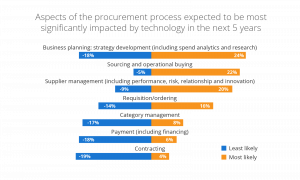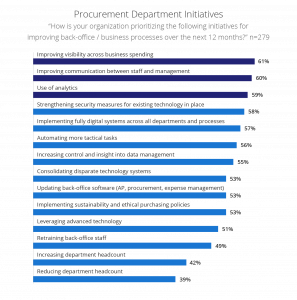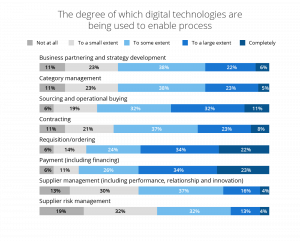As we have referred to in other blogs, procurement transformation is occurring across industries. As procure to pay processes change, procurement teams are now being tasked with more responsibilities and goals than ever before, such as managing both costs and risks within the supply chain and ensuring compliance.
With these added responsibilities, we are entering a period of procurement transformation. Procurement teams are looking to ensure that their people, processes, and technologies are best placed to deliver on critical procurement trends and not fall behind what is considered best practice within the industry.
The three pillars key to achieving procurement transformation are people, processes, and technology; however, it is vitally important that they are treated conjointly but even more so, considered in that order when implementing changes.
The Three Pillars: People, Processes, Technology
Pillar 1: People
It is often the case that technology is thought of as the sole solution to procurement transformation. Deloitte expects key areas like spend analytics, sourcing, and vendor management within procurement to be most influenced by technology in the coming years.
However, while technology offers numerous opportunities, it should be treated as the icing on the cake and not the first or only step to a procurement transformation strategy. People, in fact, hold the key to the success of such technologies and therefore must be factored in first when assessing procurement plans.
A procurement solution will not succeed if it does not have the backing of the right people, with its value and objectives explained in advance of being implemented.
There are a large number of people to consider in any organization when it comes to procurement transformation:
Procurement workforce
Procurement professionals may feel threatened by the impending arrival of an automated procurement solution. They need to be shown how their roles will change, the potential value and career path from those new roles, along with any training that will be required.
C-suite
The C-suite may seem like an obvious focus, but time and effort should be put into pitching a business case and setting expectations for procurement technology to your CFO. Of course, you need financial support to get the project off the ground, but you also can boost the focus on procurement in your organization.
Vendors
Bring vendors into the conversation at an early stage. If they are not familiar with new processes and systems, your vendor relationships and compliance could be two elements of your procurement transformation that fail.
Other departments
The likes of legal, IT, HR, marketing, customer service etc. will all be affected by any changes to current procurement systems. They also need to be involved from an early stage, with new systems and processes explained to them.
During and after the implementation of technology, regular feedback should be sought from all relevant parties in order to monitor success and make speedy adjustments where necessary.
Digital technologies are transforming day-to-day procurement processes as well as internal and external interactions. In order to keep up with the evolving landscape, Procurement leaders need to facilitate training and ongoing education for their employees.
Alarmingly, Deloitte’s Global Chief Procurement Officer Survey 2021 found that 36% of procurement leaders struggle with finding and attracting talent with the capabilities to deliver their procurement strategy. The same report also found that procurement leaders spend a meager 2.1% of their budgets on training and development.
Of those who do provide education for their teams, most are focusing on development strategies like one-to-one coaching, mentoring, and 360-degree feedback.
Pillar 2: Processes
Once all stakeholders are on board with clear roles and responsibilities, you can work on improving current processes. Improving processes is the second pillar required to achieve true success in procurement transformation.
By having strong processes in place, your procurement transformation has structure. Along with this structure, people are given responsibilities and trusted to abide by such processes both during the implementation stage and over the long-term.
A review of processes allows your organization to capitalize on some of the biggest opportunities for improvement. A report by Levvel lists gaining better visibility over spend, better communication between staff and management, and use of analytics amongst the top initiatives for procurement departments.
In another blog, we further dive into steps and procurement transformation best practices.
Including vendors in newly established changes encourages improvement of your vendor relationship management. Manual procurement processes often lead to missing or damaged POs. The resulting lengthy delays in the matching and paying of invoices leads to missed early payment discounts.
Instead, preferred vendors should be identified and interacted with on a daily basis. Once established, this process should be done through a single platform. From this platform the status of invoices can be tracked and contracts and discounts reviewed and discussed.
A review of processes also allows you to establish compliant purchasing processes as a part of your procurement transformation. Without an automated procurement solution in place, purchases may be made off-contract, budgets overspent or requisitions sent to the wrong approver, for example.
Establish purchasing rules as part of a process review, including specific budgets and preferred vendors. The creation of approval workflows will compliance with purchasing rules.
Many of the newly established and improved processes that are part of your procurement transformation will be heavily reliant on technology. Once you have the key people on board and the processes established, you can begin implementing it.
Pillar 3: Technology
Technology has the ability to unlock the true capabilities of procurement and the efficiencies and values that exist within it. However, as mentioned, they are only possible through the building of solid foundations. Getting the most relevant people to do the right things within a process ensures that processes are followed correctly. Once these things have been established, you can then choose a technology that suits your people and processes to conclude your procurement transformation.
With all three pillars working together, new and improved procurement processes have a greater chance of succeeding. The Deloitte Global Chief Procurement Officer Survey listed the likes of sourcing, ordering, and vendor management as the biggest process beneficiaries of procurement technology.
Many eProcurement solutions include vendor catalogs that offer users an online marketplace with extensive details and pricing on goods and services. With this, procurement teams can benefit from competitive pricing and quickly establish who their preferred vendors are.
The process of approving invoices is also greatly improved following the implementation of technology. The creation of rules-based workflows within your eProcurement solution prevents employees from overspending or purchasing from non-approved vendors. Workflows also shorten the invoice lifecycle, meaning vendors are paid quicker. The result is that your organization will avoid late payment fees and on the flip side, benefit from early payment discounts.
You’ll see improvement if your pillars are in place. Sourcing and payment improvements will be heavily reliant on the processes pillar of your procurement transformation. On the other hand, although you may expect technology to heavily impact spend analysis and reporting, people are actually lie at the core of its success.
In another blog, we discussed the benefits of spend analysis in your procurement process. However, for many procurement teams, detailed spend analysis is a relatively new phenomenon.
From the outset of your procurement transformation, the values of spend analysis, such as cost savings, risk management, and compliance need to be communicated to relevant procurement professionals. At a later stage, when a technology solution has been implemented, those same people may then require training in order to interpret such spend reports before the true benefits can be realized.
Conclusion
Technology holds the key to transformation in many walks of life, and procurement is no different. However, technology, on its own, will solve very little. For true procurement transformation to be realized, make sure that your organization is considering its people and processes and then choosing the technology to suit, rather than the other way around.






